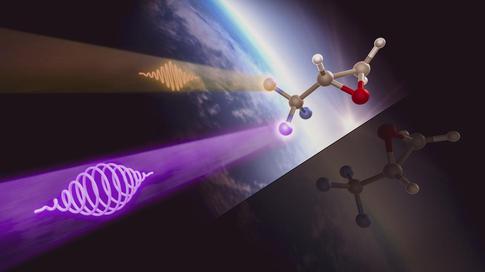XFEL: Exploring Chirality with an X-ray Laser
Exploring Chirality with an X-ray Laser
The study will open various new opportunities to investigate chiral samples, and at the European XFEL the generation of circularly polarized light is scheduled for the SASE3 soft X-ray undulator next year.
An international team of scientists led by SLAC National Accelerator Laboratory, European XFEL, and the University of Kassel performed a pioneering study on exploring chirality using ultrashort and ultraintense pulses of the X-ray free-electron laser LCLS, USA.

Illustration of the polarization controlled two-color X-ray pump X-ray probe experiment on the chiral molecule trifluoromethyloxirane, site-specifically addressing different fluorine atoms with controllable time-delay. Credit: Greg Stewart/SLAC National Accelerator Laboratory
Chirality is a fundamental phenomenon in which non-superimposable mirror images have surprising impacts on our daily life. It is, for instance, responsible for odor perception, taste, and the effect of most pharmaceutical drugs on any living organism. In fact, the molecular building blocks of all known biological matter possess a chiral, i.e., a handed, structure. The exploration of ultrafast structural and electronic dynamics in such chiral molecules can contribute to the interdisciplinary effort to ultimately understand and control chirality.
In their experiment, the scientists used the chiral model substance trifluoromethyloxirane (C3H3F3O). They made use of the fact that an electron in such a chiral system ionized via a circularly polarized photon can, under certain conditions, sense the chiral potential. Such a process ‘imprints’ the status of the chirality in the electrons’ angular emission patterns as distinct asymmetry. This phenomenon called photoelectron circular dichroism (PECD) has great potential as a tool for exploring chiral dynamics from the perspective of individual molecular sites, enabled by exploiting the high photon energy, extreme brightness, and exquisite time-resolution available at XFELs.
Stefan Moeller, principal investigator of the study at LCLS from SLAC, puts the study in perspective: “As the world’s brightest X-ray sources, free-electron lasers are promising tools to make groundbreaking contributions to this exciting topic, but so far their use in this regard has been hampered by the technological complexity,” he says. He explains that one aspect of this complexity was the demanding combination of XFEL-based polarization control for two well-controlled ultrashort pulses of different energies with tunable time delay between them. This so called “two-color X-ray pump probe” scheme using polarization-controlled XFEL pulses for the first and the second pulse had never been applied to a scientific investigation before this study. For the polarization control, the scientists employed the so-called ‘Delta’ undulator, which enables the required polarization control to create light with a handedness, i.e., helicity, as the key for interacting with chiral systems.
“The unique experimental conditions gave us the chance to observe the chiral molecule from a specific atomic site, while it was losing one of its atoms,” explains Markus Ilchen, formerly researcher at the University of Kassel and European XFEL, and now at DESY, and lead author of the recently published article in Communications Chemistry (https://doi.org/10.1038/s42004-021-00555-6).
He adds, “The complexity of the experimental conditions and data was remarkable and the lessons learnt for future experiments and data analysis approaches were as exciting as the outcome itself. This endeavor became possible only with the strong contributions from our theory colleagues.” In fact, Philipp Demekhin from the University of Kassel, and corresponding author from theory side, developed the model that yielded exciting perspectives for the dynamics of chiral systems after inner-shell ionization through X-rays. It could be a hint to better understand the evolution of stereochemical sensitivity in expanding and restructuring chiral systems.
Ilchen and Demekhin, both members of the Collaborative Research Centre 1319, are dedicated to studying and controlling chirality under extreme light conditions. They are both enthusiastic about the potential of (X-ray) free-electron lasers as unique light sources for chiral recognition. They are determined to further shape a new XFEL-based approach to ultrafast and nonlinear chirality science.
Michael Meyer, leading scientist of the SQS instrument at European XFEL and co-author on the paper adds, “It was interesting to see that this powerful method can be applied now also to FEL related studies. This will open various new opportunities to investigate chiral samples, and we are particularly excited because at the European XFEL the generation of circularly polarized light is scheduled for the SASE3 soft X-ray undulator next year.”
